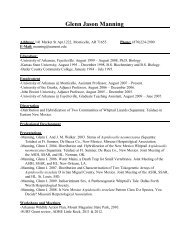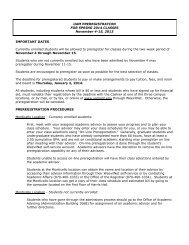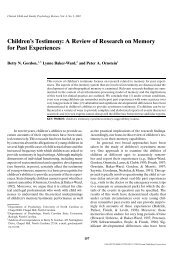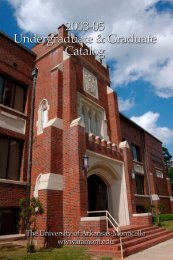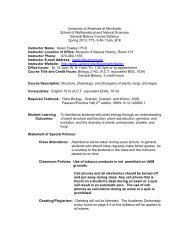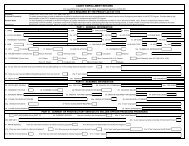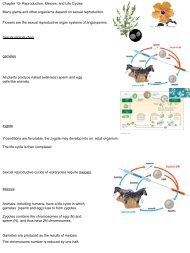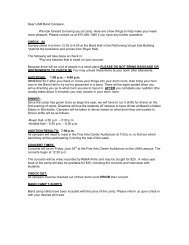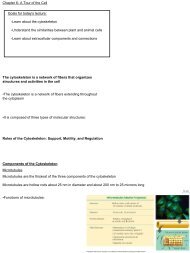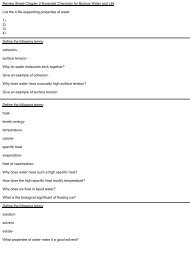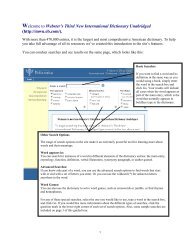Chapter 10-Photosynthesis Photosynthesis is the process that ...
Chapter 10-Photosynthesis Photosynthesis is the process that ...
Chapter 10-Photosynthesis Photosynthesis is the process that ...
Create successful ePaper yourself
Turn your PDF publications into a flip-book with our unique Google optimized e-Paper software.
<strong>Chapter</strong> <strong>10</strong>-<strong>Photosyn<strong>the</strong>s<strong>is</strong></strong><br />
Goals for today’s lecture:<br />
Review chemical cycling between photosyn<strong>the</strong>s<strong>is</strong> and<br />
cellular respiration<br />
What are <strong>the</strong> character<strong>is</strong>tics of light energy<br />
How <strong>is</strong> light energy absorbed by pigments and<br />
converted to chemical energy<br />
How <strong>is</strong> th<strong>is</strong> energy used to make ATP in photosyn<strong>the</strong>s<strong>is</strong><br />
What are <strong>the</strong> two parts of photosyn<strong>the</strong>s<strong>is</strong><br />
<strong>Photosyn<strong>the</strong>s<strong>is</strong></strong> <strong>is</strong> <strong>the</strong> <strong>process</strong> <strong>that</strong> converts solar<br />
energy into chemical energy<br />
Directly or indirectly, photosyn<strong>the</strong>s<strong>is</strong> nour<strong>is</strong>hes<br />
almost <strong>the</strong> entire living world<br />
Autotrophs are <strong>the</strong> producers of <strong>the</strong> biosphere,<br />
producing organic molecules from CO2 and o<strong>the</strong>r<br />
inorganic molecules<br />
Plants<br />
Almost all plants are photoautotrophs using <strong>the</strong><br />
energy of sunlight to make organic molecules<br />
from water and carbon dioxide<br />
Unicellular prot<strong>is</strong>t<br />
Heterotrophs obtain <strong>the</strong>ir organic material from o<strong>the</strong>r<br />
organ<strong>is</strong>ms<br />
Heterotrophs are <strong>the</strong> consumers of <strong>the</strong> biosphere<br />
Almost all heterotrophs, including humans, depend<br />
on photoautotrophs for food and oxygen<br />
Multicellular algae<br />
Cyanobacteria40 µm<br />
Purple sulfur 1.5 µm<br />
bacteria<br />
•<strong>Photosyn<strong>the</strong>s<strong>is</strong></strong> occurs in plants, algae, certain o<strong>the</strong>r<br />
prot<strong>is</strong>ts, and some prokaryotes<br />
Chloroplasts: The Sites of <strong>Photosyn<strong>the</strong>s<strong>is</strong></strong> in Plants<br />
•Their green color <strong>is</strong> from chlorophyll, <strong>the</strong> green pigment<br />
within chloroplasts<br />
The Overall Equation for <strong>Photosyn<strong>the</strong>s<strong>is</strong></strong><br />
•<strong>Photosyn<strong>the</strong>s<strong>is</strong></strong> can be summarized as <strong>the</strong> following equation:<br />
We use glucose to simplify <strong>the</strong> relationship<br />
between photosyn<strong>the</strong>s<strong>is</strong> and respiration,<br />
6 CO 2<br />
+ 12 H 2<br />
O + Light energy → C 6<br />
H 12<br />
O 6<br />
+ 6 O 2<br />
+ 6 H 2<br />
O
<strong>Photosyn<strong>the</strong>s<strong>is</strong></strong> as a Redox Process<br />
•We can simplify <strong>the</strong> equation by indicating only<br />
<strong>the</strong> <strong>the</strong> net consumption of water.<br />
<strong>Photosyn<strong>the</strong>s<strong>is</strong></strong> <strong>is</strong> not a single <strong>process</strong>, but two<br />
<strong>process</strong>es,each with many steps.<br />
The two stages of photosyn<strong>the</strong>s<strong>is</strong> are called:<br />
The light reactions convert solar energy to chemical energy.<br />
NADPH <strong>is</strong> an electron carrier, similar to NADH.<br />
The Calvin cycle begins with carbon fixation, incorporating CO2 into organic molecules<br />
The light reactions convert solar energy to <strong>the</strong><br />
chemical energy of ATP and NADPH<br />
Chloroplasts are solar-powered chemical factories<br />
Their thylakoids transform light energy into <strong>the</strong> chemical<br />
energy of ATP and NADPH
The Nature of Sunlight<br />
•Light <strong>is</strong> a form of electromagnetic energy, also<br />
called electromagnetic radiation<br />
Photosyn<strong>the</strong>tic Pigments: The Light Receptors<br />
Pigments are substances <strong>that</strong> absorb v<strong>is</strong>ible light<br />
Different pigments absorb different wavelengths<br />
Chloroplast<br />
Light<br />
Reflected<br />
light<br />
Absorbed<br />
light<br />
Granum<br />
spectrophotometer<br />
Transmitted<br />
light<br />
White<br />
light<br />
Refracting<br />
pr<strong>is</strong>m<br />
Chlorophyll<br />
solution<br />
Photoelectric<br />
tube<br />
Galvanometer<br />
•Th<strong>is</strong> machine sends light through pigments and<br />
measures <strong>the</strong> fraction of light transmitted at each<br />
wavelength<br />
Slit moves to<br />
pass light<br />
of selected<br />
wavelength<br />
Green<br />
light<br />
0 <strong>10</strong>0<br />
The high transmittance (low<br />
absorption) reading<br />
indicates <strong>that</strong> chlorophyll<br />
absorbs very little green<br />
light.<br />
Absorption of light by<br />
chloroplast pigments<br />
Chlorophyll a<br />
Chlorophyll b<br />
Carotenoids<br />
400 500 600 700<br />
Wavelength of light (nm)<br />
Absorption spectra<br />
absorption spectrum
Photosyn<strong>the</strong>tic Pigments: The Light Receptors<br />
Energy of electron<br />
Rate of photosyn<strong>the</strong>s<strong>is</strong><br />
(measured<br />
by O 2 release)<br />
•The action spectrum of photosyn<strong>the</strong>s<strong>is</strong> was first<br />
demonstrated in 1883 by Thomas Engelmann<br />
Action spectrum<br />
action spectrum<br />
Filament<br />
of algae<br />
•He used aerobic bacteria clustered along <strong>the</strong> alga<br />
as a measure of O 2<br />
production<br />
400 500 600 700<br />
Engelmann’s experiment<br />
Absorption of light by<br />
chloroplast pigments<br />
Chlorophyll a<br />
Chlorophyll b<br />
Carotenoids<br />
400 500 600 700<br />
Wavelength of light (nm)<br />
Absorption spectra<br />
CH 3 in chlorophyll a<br />
CHOin chlorophyll b<br />
Porphyrin ring:<br />
light-absorbing<br />
“head” of molecule;<br />
note magnesium<br />
atom at center<br />
Hydrocarbon tail:<br />
interacts with<br />
hydrophobic<br />
regions of proteins<br />
inside<br />
thylakoid membranes<br />
of chloroplasts; H<br />
atoms not shown<br />
e –<br />
Excited<br />
state<br />
Heat<br />
Photon<br />
Chlorophyll<br />
molecule<br />
Photon<br />
(fluorescence)<br />
Ground<br />
state<br />
Excitation of <strong>is</strong>olated chlorophyll molecule
A Photosystem: A Reaction Center Associated with Light-Harvesting Complexes<br />
A photosystem cons<strong>is</strong>ts of a reaction center<br />
surrounded by light-harvesting complexes<br />
Thylakoid<br />
Solar-powered transfer of an electron from a chlorophyll a<br />
molecule to <strong>the</strong> primary electron acceptor <strong>is</strong> <strong>the</strong> first step of<br />
<strong>the</strong> light reactions<br />
Thylakoid membrane<br />
Photon<br />
Photosystem<br />
STROMA<br />
Light-harvestingReaction<br />
Primary electron<br />
complexes center<br />
acceptor<br />
e –<br />
Transfer<br />
of energy<br />
Special<br />
chlorophyll a<br />
molecules<br />
Pigment<br />
molecules<br />
THYLAKOID SPACE<br />
(INTERIOR OF THYLAKOID)<br />
How <strong>the</strong> Light Reactions Generate ATP and NADPH<br />
Two types of photosystems cooperate in <strong>the</strong> light<br />
reactions:<br />
1.<br />
2.<br />
An electron transport chain connects <strong>the</strong> two photosystems and releases energy.
Study outline-<strong>Chapter</strong> <strong>10</strong>- <strong>Photosyn<strong>the</strong>s<strong>is</strong></strong><br />
Review – Chemical cycling between photosyn<strong>the</strong>s<strong>is</strong> and cellular respiration<br />
Autotrophs vs. heterotrophs<br />
Producers vs. consumers<br />
Photoautotrophs – plants, algae, certain prot<strong>is</strong>ts, and some prokaryotes<br />
Be able to recognize <strong>the</strong> sites of photosyn<strong>the</strong>s<strong>is</strong> and function- leaf t<strong>is</strong>sue (mesophyll), stomata, stroma, thylakoids<br />
Know <strong>the</strong> equation for photosyn<strong>the</strong>s<strong>is</strong> (understand what <strong>is</strong> oxidized and what <strong>is</strong> reduced).<br />
General overview of photosyn<strong>the</strong>s<strong>is</strong><br />
(What happens in each <strong>process</strong> Where do <strong>the</strong> <strong>process</strong>es take place in <strong>the</strong> chloroplast)<br />
1) Light reactions<br />
2) Calvin cycle<br />
Understand general principles of light energy- wave and particle (photon)<br />
Know and understand <strong>the</strong> following terms: wavelength, absorption spectra, photon, action spectra, pigment,<br />
spectrophotometer, accessory pigment<br />
Be able to recognize chlorophyll a and b<br />
Understand <strong>the</strong> components of a reaction center and how light energy <strong>is</strong> converted to chemical energy<br />
Know <strong>the</strong> two types of photosystems <strong>that</strong> participate in <strong>the</strong> light reactions<br />
(What happens in each photosystem)<br />
1) Photosystem II<br />
2) Photosystem I



